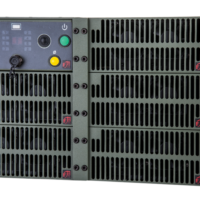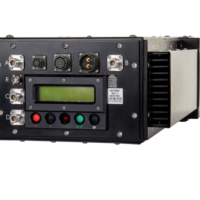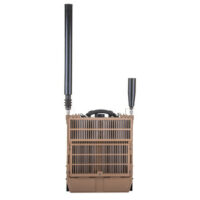Jamming underpins the electronic attack mission. Electronic attack is a subset of the wider Electronic Warfare (EW) discipline.
Jamming technology was first used offensively during the Second World War to attack radars and radios. Both these latter systems transmit radio signals. Radars do this to detect and track an object, radios do this to send and receive voice and data traffic.
At its simplest, jamming is intended to degrade the ability of radars or radios to perform their tasks, or even prevent them from doing so altogether. The jamming process also harnesses radio signals but does so in such a way as to attack these systems.
How Jamming Systems Work
Put simply, jamming equipment uses artificially created radio interference offensively. An example of how jamming works can be witnessed when a car drives under a powerline with its radio on. The sound of the radio suddenly becomes drowned out by interference. This is caused by the electromagnetic radiation from the powerlines.
A jamming signal, known as a waveform, will be transmitted towards a radar or radio’s antenna. The intention is for the antenna to detect this signal. To ensure this occurs, the signal is transmitted on a frequency which can be detected by the antenna and which matches the frequency of the signal the jamming is targeting: If a radar is transmitting its signal on a frequency of 3.6 gigahertz/GHz, the jamming signal must be the same.
However, jamming a radar or radio successfully not only depends on the jamming signal’s frequency. Signal amplitude is also important. Let us consider a radio receiving traffic with amplitudes at a certain number of watts. If the jamming signal is weaker than the signals received by the radio then those latter signals will be left undisturbed. The jamming signal will be detected too but will be too weak to have any discernible effect.
If the jamming signal is stronger than the traffic received by the radio it will ‘wash out’ the former. In electronic warfare, jamming is effective when the radio or radar is receiving rather than transmitting. This is because the incoming radio signals will already be comparatively weak. This reduces the power levels the jammer needs to be effective.
To explain how jamming works, imagine a solo violinist and a heavy rock band on the same stage. The solo violinist starts to play but their music immediately becomes inaudible when the rock band starts. This does not mean that the violinist’s music has stopped, merely that the loudness of the band drowns out the soloist.
Electronic Jamming Tactics
Jamming technology has increased in sophistication as electronic warfare has developed and includes an array of tactics.
Barrage jamming is performed against two or more frequencies. This can be useful when the aggressor does not know exactly which radio or radar frequencies their adversary is using. Nonetheless, they may know with reasonable certainty which waveband of frequencies they may be using.
Spot jamming is performed against specific frequencies known to be in use.
Deception Jamming – the advent of solid-state electronics in the 1960s revolutionized jamming. It enabled the development of sophisticated Digital Radio Frequency Memory (DRFM) systems. These are particularly useful for jamming radars. DRFMs detect an incoming radar signal, sample that signal and then subtly alert it, before retransmitting it back to the radar. This new, but false, signal could confuse the radar by presenting two or more targets where there was previously only one. It could show the target as appearing to travel faster or slower than it actually is. This tactic is known as deception jamming.
Seduction Jamming – likewise, false signals could be composed by the DRFM and transmitted to convince the radar there is a far more prominent or attractive target in its field-of-view rather than the one it originally detected. This tactic is known as seduction jamming. Over the long term, the advent of artificial intelligence techniques will make jamming tactics and techniques ever more sophisticated.

















